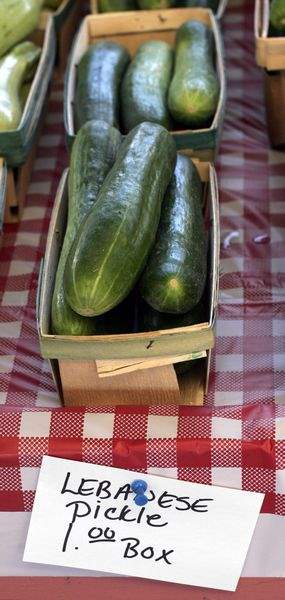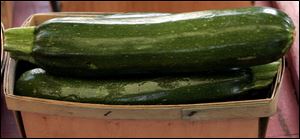
From farm to table
8/16/2005
FUD farmkt30p Toledo Farmers Market, Erie St. vegetables. The Blade/Diane Hires 7/30/05
Hires / Blade

FUD farmkt30p Toledo Farmers Market, Erie St. Zucchini. The Blade/Diane Hires 7/30/05
It s the height of the growing season in northwest Ohio and a perfect time to take advantage of the season s bounty of ripe produce. Prepare side dishes, salads, even soups, and main dishes with as much of this season s crop as possible.
Locally grown produce is as close as farmers markets, roadside stands, and gardens. Some supermarkets and specialty stores sell locally grown produce.
Along the way, you may find some sources for locally grown organic produce. (Organic foods must be produced or grown without synthetic or unnatural influences, such as antibiotics, growth stimulants, or genetically modified grains, chemical fertilizers, pesticides, herbicides, or fungicides.)
"There is more locally grown than organic locally grown at the markets and stands," says Carol Goland, executive director of Ohio Ecological Food and Farm Association. "Watch for more organic in the future. It s more profitable than conventional. A premium price is [often] paid for organic foods."
Some supermarkets have a wide variety of organic produce, much of which is shipped from California. Even Phoenix Food Co-op, 1447 West Sylvania Ave., relies on California and South America for organically grown produce in the off-season, according to manager Chad Olson. But when summer comes, they turn to on local growers such as Ed Lachowski of Waterville and Phil Sherry of Oakwood, Ohio.
Not all organic growers are certified organic. "Some farmers haven t gone through the certification process so we call it unsprayed or naturally grown," says Mr. Olson.
Based on availability, Mr. Lachowski also sells his produce grown with "organic and the least toxic farming practices" at the Waterville Farmers Market on Saturdays. Last Saturday, he expected to have tomatoes, cucumber, squash, and zucchini.
Mr. Lachowski, who said he used to do organic research for the Rodale Institute in Pennsylvania, also provides produce to Cohen & Cooke, Inc., World Market at 109 South Main St. in Bowling Green for the weekend menu.
"The organic certification process is lengthy," says Mike Sader, chef-owner of Cohen & Cooke, which is open for dinner Thursday through Saturday and for lunch weekdays and Saturday. "Ed grows everything [with certified methods]. My wife, Kim, got to know him at the farmers market in Waterville. Last year he planted 900 heirloom tomato plants for us. We get our herbs and squash exclusively from him."
The restaurant changes its menu every night, so "he can experiment with what he grows," says Mr. Sader. "We can buy in any quantity he has. This weekend I have no idea what he ll have. He calls Thursday afternoon or Friday morning and says I have this, and this, and this. And we say what we need. His network of friends allows us to get into organic blueberries and cherries and other fruits and vegetables."
One unique item is the strawberry spinach, which has a little berry on it. "We use this as a garnish," says the chef, who also likes the malabar spinach and black kale that he gets. "Many I m familiar with from Napa Valley." Mr. Sader was the executive chef at the Catahoula Restaurant and Saloon in Calistoga, Calif., for several years before returning to Ohio.
"Consumers have been conditioned to getting a perfect looking product," says OEFFA s Ms. Goland. "The varieties selected [for shipping] must withstand transporting and sitting on a shelf in the supermarket. When farmers sell locally, they can choose varieties that don t need those qualities. They can choose products that are more flavorful and have a greater diversity of varieties within one crop. That s why chefs often choose locally grown."

FUD farmkt30p Toledo Farmers Market, Erie St. vegetables. The Blade/Diane Hires 7/30/05
Some area growers have their own farm market such as Wardell s Farm Market in Waterville. "We spray as little as possible," says owner Tom Wardell, past president of the Toledo Area Flower and Vegetable Growers Association. Right now he s selling summer squash, beans, corn, hot peppers, and melons. "We also sell to Sautter s [Food Center]. Our growing season is so short. We have good quality but can t supply year round."
Phil Sherry of Oakwood, near Defiance, is an organically certified farmer. In recent weeks, he s supplied wild greens, corn, and fresh herbs like parsley, basil, and mint to Phoenix Food Co-op. He also sells his produce at the Defiance Farmers Market, which is open 3 to 6 p.m. Thursdays and 9 to noon on Saturdays.
"I deal with a half dozen restaurants from time to time," says the owner of Nothing But Nature. All are in the Defiance area.
I found the Luginbill Family Farm booth at the Perrysburg Farmers Market on Thursdays starting at 4 p.m. Based in Pandora, the farm raises free-range eggs, grass-fed beef, pastured pork, free-range broilers, and free-range turkeys.
Erika Rapp, executive chef at Diva s, is a regular customer on Saturday mornings at the Toledo Farmers Market. "I try to go to the farmers market each Saturday before I come in to work," says the Toledo native who attended the Culinary Institute of America. "It keeps me in touch with what s fresh. I also use free-range chicken from a grower in the Waterville area."
Last week, she found yellow plums that she used in a fruit tray for a private party at Diva s. Yellow heirloom tomatoes were served with the flat-iron steak and panzanella salad (an Italian bread salad). "I m always looking for tomatoes; at this time of year, it s No. 1, as well as summer squash, stone fruits like plums and peaches, and herbs," says Ms. Rapp.
"I think it s important to see what farmers have. It keeps things regional."
Her advice is good for the home cook as well.
Take advantage of the zucchini harvest. Oven-Fried Zucchini Sticks is a healthier alternative to fried zucchini. Zucchini is also great for casseroles, stir-fries, and pasta dishes.
Try grilling eggplant for Grilled Eggplant Parmesan. Even if you are a fan of traditional fried eggplant Parmesan, the fantastic flavor of this recipe will win you over. The recipe can also be adapted to zucchini.
When selecting sweet corn, look for bright green, moist husks and stiff, dark silk. Serve the corn the same day or keep it refrigerated until you are ready to prepare it. Boil, grill, or microwave corn. Roasted Corn and Black Bean Relish from A Taste of Ohio History by Debbie Nunley and Karen Jane Elliott (Blair, $18.95) is credited to the Vernon Manor Hotel in Cincinnati.
On a warm summer afternoon or evening, Cold Cucumber Soup is delicious. It s best not to overblend this recipe from Marion Cunningham s Lost Recipes (Knopf, $22). Leave some of the cucumber in rough pieces for texture.
As the crop of local green peppers brings down the price of the vegetables, it s a great time to make stuffed green peppers. Serve green bell peppers in salads, as crudites, or in stir-fry.
Buying locally grown makes any kitchen s repertoire of regional and family favorites all the better.